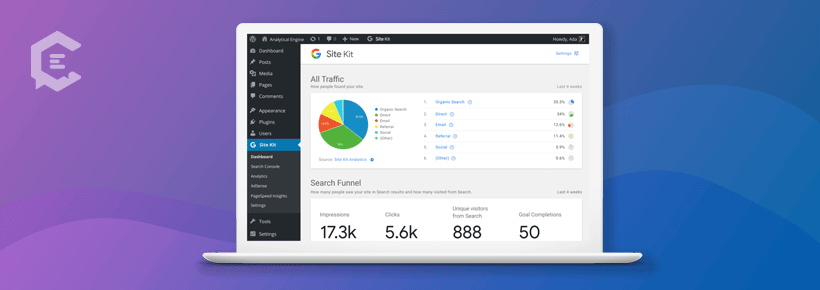If you’ve ever installed Google Analytics on a WordPress website, you’ve seen that you’ve got dozens of options for setup; you can simply use header/footer plugins to simply place the Google Analytics tag or you can use one of a myriad of plugins that gives additional features such as reporting and dashboards from within your WordPress backend.
Which Google Analytics WordPress plugin should I use?
In setting up client websites, it’s generally easy to choose a plugin for them and simply explain why I’ve chosen that given plugin. However, we sometimes run into a more involved client who wants to know every intimate detail of which plugins we’ve chosen, and why. In the past, it was requisite that you understood each of the main WordPress plugin options for integrating Google Analytics so you could ensure your clients (or your employer) that you were setting up the right package.
Following the Google Analytics WordPress plugin space was no easy task, especially as new plugins came along to unseat previous incumbent winners. For example, 2013 brought us the plugin Google Analytics Dashboard for WordPress (GADWP), which over the years became the most popular plugin, changed ownership hands a few times, and was rebranded along the way. MonsterInsights, a plugin that came before GADWP didn’t become the incumbent winner until more recently, and has now added on so much functionality that it is the plugin to beat.

Source: WordPress plugin page
While there are hundreds of articles out there that review or recommend WordPress Google Analytics plugins, one common thread that you’ll see is they almost all include Google Analytics Dashboard for WordPress and MonsterInsights. While both GADWP and MonsterInsights have very similar functionality, MonsterInsights has more active development (releases happening every few weeks vs. months) and a wider user base (2+ million installations vs. 1+ million). As you can see in the current header banner on its WordPress plugin page, MonsterInsights also claims that it is the “best Google Analytics plugin for WordPress.” Because MonsterInsights seems to have emerged as the plugin of choice over the last few years, we’ll be comparing the upcoming Google Analytics Site Kit with MonsterInsights.
Google Site Kit vs. MonsterInsights
Google’s soon-to-be-released Site Kit is poised to unseat MonsterInsights as the leading Google Analytics integration plugin for WordPress. One of the major features of MonsterInsights was that you could display your most common report metrics from Google Analytics inside a dashboard that you could view right from WordPress. If you were looking for basic metrics like the number of user sessions or page views on a given day, you could see it right in WordPress and didn’t need to open a new tab to navigate to Google Analytics. This was the major benefit of MonsterInsights over the dozens of other WordPress plugin options available to site builders. There are a few other key differentiators that MonsterInsights provides its users.
MonsterInsight’s three main differentiating features include:
- Easy installation. MonsterInsights has always made it easy to install Google Analytics. All you need to do is copy and paste your Google Analytics unique identifier code into the plugin, and it works. For those of you using the most recent plugin iterations of MonsterInsights, it is even easier than that. You simply click a button and it has you log into Google Analytics and authorize the connection.
- Basic metrics viewable in WordPress backend. MonsterInsights enables you to view some of your more basic site traffic metrics from right inside your WordPress backend. No need to open another tab and load up Google Analytics.
- E-commerce tracking integration. Setting up e-commerce tracing inside of Google Analytics is extremely easy if you’re using a content management system and shopping cart like Shopify. It’s a little more tricky with WordPress-based shopping carts, such as WooCommerce, though. So MonsterInsights does it for you: Simply install a MonsterInsights extension plugin and you can integrate your WooCommerce product tracking data into Google Analytics.
What are Google Site Kit’s differentiating features?
While Google hasn’t yet released Site Kit to the general public, from their documentation and discussing with individuals in the know, I’ve been able to determine that the main features Site Kit is going to offer include:
- Easy installation. Google isn’t publicly explaining exactly how their WordPress plugin installation will work, but from what I’ve been able to put together the process will be very similar to MonsterInsight’s latest improvements in this space, where a user simply clicks a button in WordPress to authenticate on Google’s server and give permission for that site to integrate with the Google Analytics account. What differentiates Google’s plugin from MonsterInsight is that Google’s offering will also allow you to one-click install AdSense, Search Console, and PageSpeed Insights.
- More than just basic metrics viewable in WordPress backend. Perhaps one of the big advantages Google is poised to have over MonsterInsights is that the Site Kit plugin will have extra metrics viewable from within the WordPress backend. Going beyond just simple site metrics such as the number of sessions and pages viewed, you’ll also be able to view customer funnel data from search engine originating traffic or data on what Google thinks you can do to optimize the speed of your site.
- Milestone alerts to push progress. While details around this offering are still a little opaque, Google’s Site Kit offering will include alerts you will see when you log into WordPress that tell you what milestones you’ve hit, site traffic or performance wise, and encourage you to keep going. This will be a great feature for small to medium businesses that need a little extra hand-holding in their journey to growing site traffic.

In addition to researching around the web, and talking with a few friends and industry insiders that are in the know, we have put together a few of the most commonly asked questions, with my best effort at answering those. As we are given permission to fully review and share the review of the Site Kit product, I’ll be sure to update this article with a true head-to-head review between Google Site Kit and MonsterInsights.
For now though, here are some answers to some questions you may have about the Google Site Kit product:
Several FAQs about Google Site Kit
When can I get Google Site Kit?
Google Site Kit is currently taking signups for beta users and will be expanding their program in “early 2019,” per their press release.
So, more glorified Google Analytics?
Not at all. While it will directly be competing with MonsterInsights and other WordPress plugins, Site Kit offers so much more than just Google Analytics. Notice that it is not called “Google Analytics Site Kit”, but has instead been branded as “Google Site Kit.” This is because it is integrated with other Google products such as Search Consoler and PageSpeed Insights, in addition to Analytics.
Will Site Kit allow you to track third-party search engines, such as DuckDuckGo?
Not out of the box, as Google doesn’t currently consider DuckDuckGo as one of their “default search engines” inside of Google-Analytics. You can, however, follow these simple instructions to edit the list of search engines in Google Analytics, which will change your reporting data. In looking how MonsterInsights and other WordPress plugins handle the rendering of Google Analytics data in WordPress dashboards, we expect that following those instructions to change your search engine inclusion settings in Google Analytics should be reflected in the new dashboards provided by Site Kit.
Will Site Kit have integrations with e-commerce solutions, such as WooCommerce?
Probably not right away. MonsterInsights has worked tirelessly to integrate their solution with other third-party apps, such as WooCommerce. From what I’m hearing, Google is currently focused on getting their key offering up and does not have an easy integration option with WooCommerce (or similar apps) on the immediate horizon. That said, there are two redeeming points to consider:
- The Site Kit toolset is open source, meaning WooCommerce will likely be able to create their own integration with Site Kit to get those two systems talking more easily. Google has also promised to expand the Site Kit solution to other products in the Google wheelhouse, meaning that they’ll likely have an extensive API for internal product teams that we could see them making available to other developers.
- Google has promised to allow Site Kit to work well with other tools, such as MonsterInsights, so you could run both in tandem until Google’s product is fully up to speed, and then simplify down by cutting out other third-party plugins.

Can Google Site Kit beat MonsterInsights?
Not immediately. MonsterInsights has put a lot of effort into creating a wonderful tool for integrating Google Analytics with WordPress websites, and their solution will likely remain the winner in the short term. That said, we think all serious web developers will also be installing Google’s Site Kit in the short term, and eventually using it to entirely replace MonsterInsights. We give MonsterInsights 18 months before they start to see their installs taper.
Read More Martech articles:
- Graded Comparisons: Wix vs. Squarespace vs. Weebly
- Customer Messaging Platform Showdown: Drift vs. Intercom
- Storytelling Tools Put to the Test: Piktochart vs. Canva vs. Visme
- Hootsuite vs. Buffer: We Rated 10 Key Factors for Each



